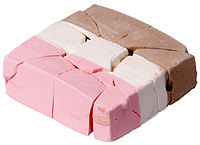
Photo from wikipedia
Technology such as the use of microfluidics to generate liposomes has been well researched, yet the stabilisation of liposomal formulations is a major challenge to their greater implementation. To the… Click to show full abstract
Technology such as the use of microfluidics to generate liposomes has been well researched, yet the stabilisation of liposomal formulations is a major challenge to their greater implementation. To the best of our knowledge, this is the first study investigating the use of 96 well plates to freeze-dry ovalbumin (OVA) loaded neutral (DMPC:Chol and DSPC:Chol), anionic (DSPC:Chol:PS) and cationic (DSPC:Chol:DOTAP) liposomes. Through the use of high throughput screening, a freeze drying cycle was optimised; ramp freezing from from 4°C to -45°C, followed by primary drying at -30°C and secondary drying at 30°C under a vacuum of 0.1 mBar. These parameters maintained liposome physicochemical properties, with the liposomes remaining below 100 nm and were homogenous (polydispersity index of less than 0.2 post rehydration). Minimal leakage of the OVA protein was observed, with almost 100% OVA remaining encapsulated post rehydration of the formulations. Here we have identified a simple method that allows for the rapid screening and freeze-drying of a range of liposomal formulations.
Journal Title: International journal of pharmaceutics
Year Published: 2019
Link to full text (if available)
Share on Social Media: Sign Up to like & get
recommendations!